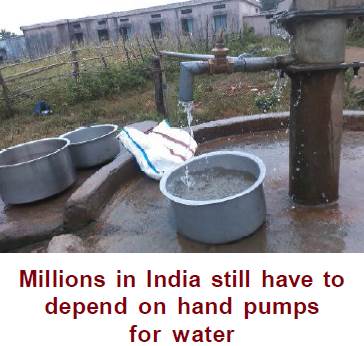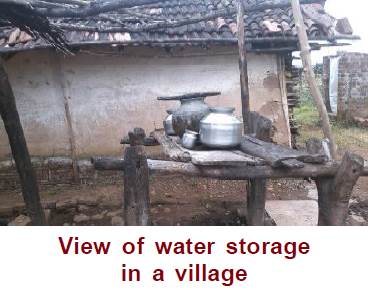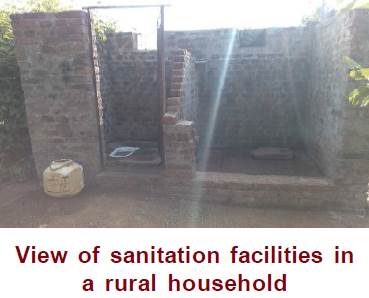|
Ensure Availability and
Sustainable Management Transiting from MDGs to SDGs T he Millennium Development Goals have got a new term - Sustainable Development Goals on account of the efforts of the local and global development practitioners, bilateral and multilateral agencies, private sector and
our governments. The Post-2015 Sustainable Development Goals (SDGs)
represent the development of a thematic extension of the Millennium
Development Goals (MDGs). While the MDGs specifically focussed on health
and social wellbeing, the SDGs also emphasise on environmental problems
and economic growth. The agenda of the SDGs is changing according to the
way the international community is thinking about development and
cooperation through discussions that transcend the reduction of poverty
and draw particular attention to environmental restrictions (http://www.raci.org.ar).
Over a period of time, tracking and monitoring the SDGs will have to be
at the forefront; unlike the MDGs which only got attention towards the
ending years, as we approached 2015 - the ‘Target Year’. agencies, private sector and
our governments. The Post-2015 Sustainable Development Goals (SDGs)
represent the development of a thematic extension of the Millennium
Development Goals (MDGs). While the MDGs specifically focussed on health
and social wellbeing, the SDGs also emphasise on environmental problems
and economic growth. The agenda of the SDGs is changing according to the
way the international community is thinking about development and
cooperation through discussions that transcend the reduction of poverty
and draw particular attention to environmental restrictions (http://www.raci.org.ar).
Over a period of time, tracking and monitoring the SDGs will have to be
at the forefront; unlike the MDGs which only got attention towards the
ending years, as we approached 2015 - the ‘Target Year’.
The Efforts vs. The Challenges A large number of countries have committed - some
financially, some politically - to combat the life influencing health
burdens and reduced disability-adjusted life years (DALYs) arising as a
The UN-Water Global Analysis and Assessment of Sanitation and Drinking Water (GLAAS 2014), published biannually, presents data from 94 countries and 23 external support agencies that helps to point out critical challenges even today. These include insufficient financing, funding gap in rural areas, weak national capacities to execute WASH (water, sanitation and hygiene) plans and critical gaps in monitoring of WASH in schools and health facilities. Transiting from MDG to SDG for Water and Sanitation Achieving the water MDG is a welcome situation.
However, sustaining it is going to be a major challenge due to inter and
intra state vis-à-vis trans boundary issues. The ‘global alarm’ is that
Everyone should demand for transparent, participatory, relevant (need based, cost effective), inclusive (equity and accountability with civic responsibilities) models of operation and maintenance and implementation of water and sanitation service delivery to each of us against all competing priorities. We must realise that collectively we failed miserably on meeting the targets for sanitation although we say we succeeded in realising the goal on water supplies! The transition from MDGs to SDGs has left us with a big question/ debate - Have we really understood the meaning of Water and Sanitation for All? q Anand Ghodke
|
 result of poor water supply and sanitation situation. A few nations are
yet to understand the social, health, economic and environmental
consequences of lack of clean drinking water and sanitation facilities
while a few countries lack resources but are willing to address this
problem. A positive development is that technical, strategic, knowledge
and financial resources are being made available locally or through aids
from the developed world to the developing and under-developed
economies.
result of poor water supply and sanitation situation. A few nations are
yet to understand the social, health, economic and environmental
consequences of lack of clean drinking water and sanitation facilities
while a few countries lack resources but are willing to address this
problem. A positive development is that technical, strategic, knowledge
and financial resources are being made available locally or through aids
from the developed world to the developing and under-developed
economies. it is a ‘temporary situation’ and we are not sure how long it will last;
particularly for two major reasons. First being the emerging discourse
on global warming and climate change becoming a circumferential
phenomenon which may overshadow the basic issue of water and sanitation
and likely to make it a lower priority area. In the name of economic,
industrial oriented economic development or growth; water and sanitation
may become more commercial than a basic fundamental right. The current
trend is inching towards the commercialisation and privatisation of
these services. Secondly, the gross lack of investment for operation and
maintenance of the water and sanitation infrastructure is a huge
problem.
it is a ‘temporary situation’ and we are not sure how long it will last;
particularly for two major reasons. First being the emerging discourse
on global warming and climate change becoming a circumferential
phenomenon which may overshadow the basic issue of water and sanitation
and likely to make it a lower priority area. In the name of economic,
industrial oriented economic development or growth; water and sanitation
may become more commercial than a basic fundamental right. The current
trend is inching towards the commercialisation and privatisation of
these services. Secondly, the gross lack of investment for operation and
maintenance of the water and sanitation infrastructure is a huge
problem.